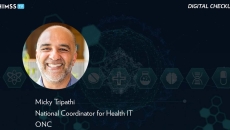interoperability
Dr. John Blair, CEO of MedAllies, discusses the benefits and use cases of a qualified health information network, places where interoperability falls short in the healthcare sector and the opportunity for QHINs to increase connectivity.
The company offers tools to payers and providers to share patient health information and will use the funds to scale its operations.
Micky Tripathi, ONC national coordinator, discusses TEFCA's FAST track to FHIR exchange, the FHIR roadmap, concerns among EHR vendors on electronic case reporting and supporting data scalability to enable payers to advance interoperability.
Jennifer Goldsack, CEO of the Digital Medicine Society (DiMe) and cohost of CancerX, highlights ONC's annual meeting and how data with interoperability, privacy and security protections can fundamentally change oncology outcomes.
Holly Miller, chief medical officer at MedAllies, discusses the Sequoia Project's Data Usability Taking Root initiative around adoption of the Data Usability Implementation Guide, which underscores interoperability of trustworthy, usable data.
HIMSS23
Nathan Shepard, Azalea's VP of product, discusses how his company is helping rural providers improve patient care and profitability.
HIMSS23
The DHA's assistant director of healthcare administration, Dr. Brian Lein, as well as FEHRM Director William Tinston and Holly Joers, program executive officer for PEO DHMS, discuss the federal joint Health Information Exchange.
HIMSS23
Michael Palantoni, vice president of platform and data services at athenahealth, discusses some of the benefits the healthcare industry will experience once true nationwide interoperability is achieved.
HIMSS23
Drew Ivan, Rhapsody's chief strategy officer, discusses how health systems can leverage digital solutions to manage data more efficiently while building regulatory compliance and flexibility into their IT infrastructure.
HIMSS23
Gabriel Garcia-Lopez, health information systems director for the Los Angeles LGBT Center, discusses diversity, inclusion and the importance of using C-COMM to evaluate how well a patient is cared for within their community.








